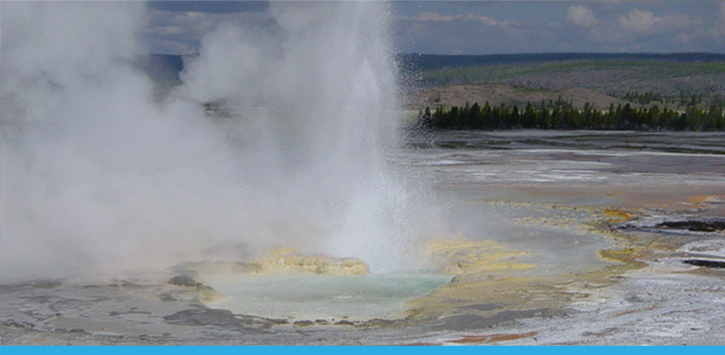Over 3,000 gallons of scalding water spew into the atmosphere, reaching heights over 100 feet. Visitors watch in awe as nature gives a taste of the power it wields. Lasting for just a few fleeting minutes, it provides just enough time to put on a show to sear into the memories of all who witness. After the grand performance is finished, the crowds disperse, silence takes over and the stillness of nature, excluding rowdy tourists, again takes hold.
Certainly, Old Faithful is one of the crowning jewels of Yellowstone National Park and a geological wonder. However, it would be erroneous to state that Old Faithful is the only intriguing thing in the park. Teeming with gorgeous landscapes, massive amounts of biodiversity and of course, geysers, Yellowstone is a site to behold in all its glory. To scientists though, it is so much more than just a pretty place to take selfies, it is a geological and scientific wonderland.
The United States Geological Survey, established in 1879, is an organization that studies the geology of the U.S. and provides critical information to the public. One of the survey’s many observatories includes none other than the Yellowstone Volcano Observatory, opened in 2001. In this observatory, assessments of various geological activities take place both to inform the public and learn more about Yellowstone. Here is where scientists who devote their life to science study what happens behind the scenes at Yellowstone, beneath the beautiful façade of the park.
Meet a Geophysicist at the U.S. Geological Survey
Michael Poland, a geophysicist at the US Geological Survey since 2002 and the scientist-in-charge of the Yellowstone Volcano Observatory since 2017, agreed through email to give insight on his and his colleagues’ work at the observatory. Commenting on his position at the observatory, Poland stated, “…my job is to coordinate work in Yellowstone and guide any hazard communications. I also research volcanic activity in Yellowstone and elsewhere (primarily in the Cascade Range and Hawaii), especially as it relates to ground deformation — how the ground moves due to movement of magma and faulting beneath the surface.”
Poland later gave more information not only on his job, but his co-workers’ jobs as well. “We all have different specializations and different interests. Some of my colleagues focus on geyser activity. Or gas emissions. Or earthquake activity. Collectively, we study all aspects of Yellowstone geology, geophysics, and geochemistry, from current changes to the geology of past eruptions (which can be a guide to future activity).”
Studying Yellowstone, however, is more than just looking at data and holding scientific research. It is being a beacon of truth for the public. Many are aware that Yellowstone is also in fact a volcanic caldera and a supervolcano. According to the National Park Service, the caldera has had three super-eruptions before, all within 2.1 million years. With this knowledge comes misinformation and exaggeration from the news leading to unnecessary panic. Some of the worst offenders of yellow journalism are quite unapologetic in their coverage of Yellowstone, refusing to correct misinformation.
Understanding Yellowstone Research
As part of his response, Poland touched on this by saying, “We also communicate with the public — answering questions, giving presentations, and so forth, to ensure that accurate information is available. I think this is especially important given that Yellowstone is a subject of quite a lot of misinformation and exaggeration online, in tabloids and documentaries, etc.” In case anyone is anxious about the volcano, the National Park Service has said, “Another caldera-forming eruption is theoretically possible, but it is very unlikely in the next thousand or even 10,000 years. Scientists have also found no indication of an imminent smaller eruption of lava in more than 30 years of monitoring.”
On a lighter note, when asked why he and his colleagues find Yellowstone to be a source of interest, Poland responded, “It’s dynamic! Yellowstone is always changing.” Poland expressed the allure of the park in his reasoning for why Yellowstone is such a unique location, saying, “Seismic swarms come and go. The ground moves up and down. Geysers stop and start. Even “regular” geysers, like Old Faithful, are completely captivating! Change is a constant at Yellowstone, and that makes the place especially exciting for a geologist. Couple that with the innate beauty of the landscape and ecosystem, and it’s hard to resist.”
There you have it folks, a brief look into the duties of scientists who devote their time to Yellowstone and geology. With this new insight on one of the United State’s most popular and geological diverse national parks and the research done there, this article does conclude.
Before you go, have you ever been to Yellowstone or another national park? If not, which park do you want to visit?
Photo: Clepsydra Geyser at Fountain Paint Pot in Yellowstone
Written by Ryan Raley, Technology Editor


Hello, Ryan! My name is Brooklyn Urquhart and I was just wondering if you would like to do an article for my FLVS News section with me? If you don’t, I totally understand! Have a great day.